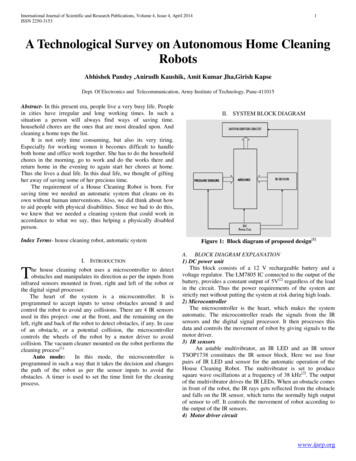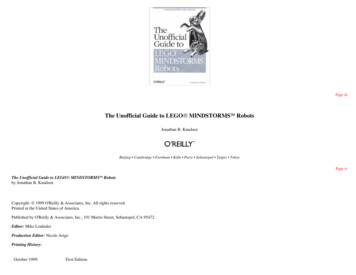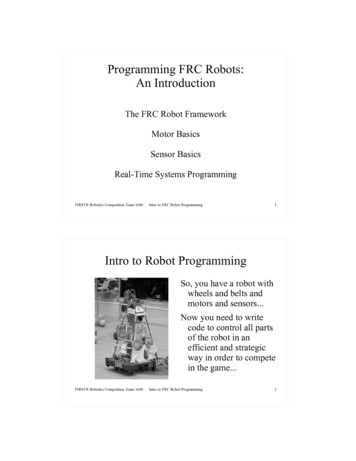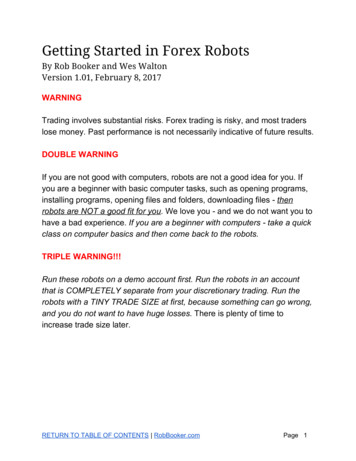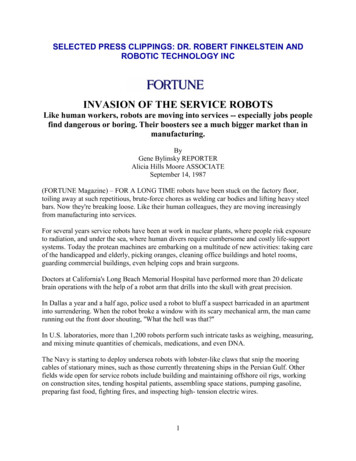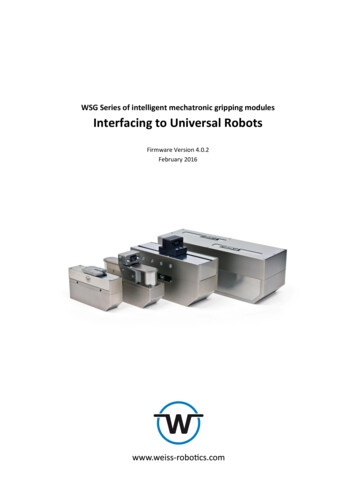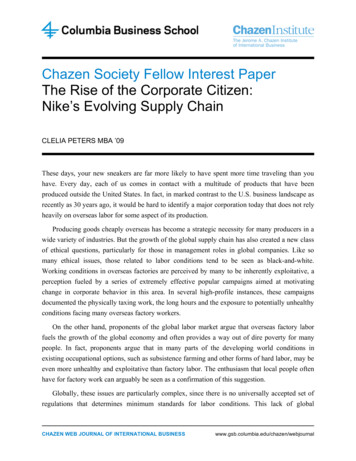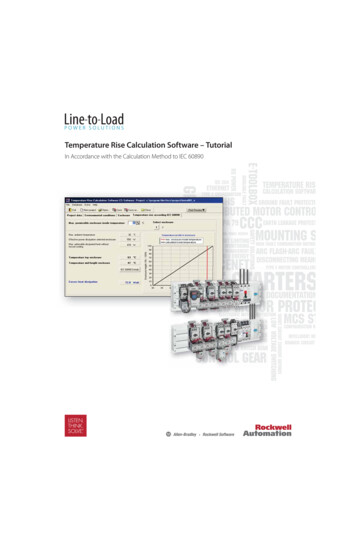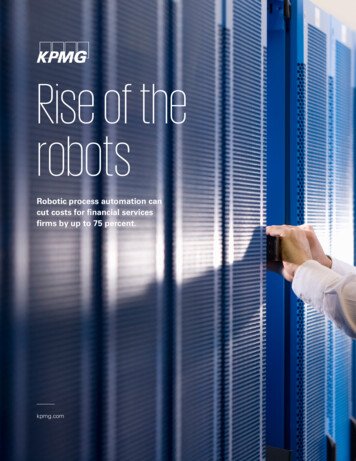
Transcription
Rise of therobotsRobotic process automation cancut costs for financial servicesfirms by up to 75 percent.kpmg.com
About the contributorsBill Cline: Bill was recently named KPMG’s Strategic Capabilities and Alliances leader todrive innovation across the Financial Services Advisory practice. With more than 30 yearsworking in the world’s financial markets, he has designed and introduced some of themost impactful tools in capital markets, including the first digital trading systems, the firstcommercial ticker plants, new methods of market data delivery and services, and thegrowth of global sourcing and asset-driven capabilities in professional services.Michael Henry: Mike is a principal in KPMG’s Advisory practice based in New YorkCity. In his 25-year career, he has helped financial services organizations transform toimprove performance. He has lived and worked abroad for more than 15 years, including6 years in Europe and 9 years in Asia, delivering value to local and global clients inbanking, capital markets, and insurance.Cliff Justice: Cliff is a principal in KPMG’s Innovation & Enterprise Solutions team,leading the firm’s Cognitive Automation initiatives. He is a leading authority on globalservice delivery model design and sourcing, with more than 25 years of experiencein operations, technology, outsourcing, offshoring, and business transformation.Cliff has been an early leader in applying intelligent automation, robotics, and cognitivetechnologies to business operations and services.
ContentsIntroduction2Embracing technology and transformation3–– New disruptors and their high-tech capabilities 4“Offshoring” no longer a solution 6Benefits of ‘bots7–– Case study: Upping the bet on ‘bots 8So what’s the holdup?9Nine steps for RPA innovation10–– Presenting to senior management or the board 11–– Case study: Integrating RPA gradually 11Using RPA in the client onboarding process 12Impact on employees – and getting their buy-in14What lies ahead?16About KPMG17Contact us18Rise of the robots1
Introduction“In the next 15 years, it’s likely that 45 percent, andmaybe up to 75 percent, of existing offshore jobs in thefinancial services sector will be performed by robots,1or more precisely, robotic process automation (RPA),”stated Cliff Justice, KPMG LLP (KPMG) Advisory principal.“That should translate into enormous costs savings ofup to 75 percent2 for firmsthat get on board.”into their operations will not only find themselves at ahuge disadvantage, they likely will be as obsolete as theemployees that the robots have replaced,” said Justice.Powerful words. provocative predictions In this paper, we take a look at what’s behind these boldforecasts. We also exploresome of the benefits thatrobots and AI/cognitiveautomation technologyholds, including the abilityto digest and analyze hugeamounts of data. Finally,we present nine factorsyou should consider beforeimplementing an RPAstrategy.“Success in today’s financialmarkets requires unprecedentedlevels of speed, accuracy, andcost efficiency beyond what ahuman workforce can provide.”And the potential benefitsdon’t stop there. ”Successin today’s complex globalfinancial markets requiresunprecedented levels ofspeed, accuracy, and costefficiency beyond whata human workforce canprovide,” observed Bill Cline,We strongly believe thatKPMG Advisory principal.—Bill Cline, KPMG Advisory principal robotic and cognitive“That’s why firms in theautomation is the wave offinancial services marketsare increasingly turning to RPA and artificial intelligencethe future for global capital markets and financial services(AI)-driven cognitive automation to transform theirfirms. It’s crucial that you explore what you can do today tobusinesses.”position yourself for success tomorrow.As technology improves, robots will be able to do moresophisticated tasks faster and more efficiently thanhuman workers. “Businesses that don’t start takingsteps now to integrate robotics and cognitive automationWe welcome your feedback on this topic and invite you tocontact our specialists for further discussion.1 e are defining a robot as a technology or technology-enabled process that can perform functionsWpreviously only performed by humans.2 obotic process automation: The new IT job killer, InfoWorld, March 23, 2015; Framing a ConstitutionRfor Robotistan: Racing with the Machine of Robotic Automation, Charles Sutherland, HfS Research,October 2013
Embracing technologyand transformation“Although capital markets have been expanding globally,”observed Cline, “there’s been an increase in competition fromtraditional competitors as well as from disruptive new entrantsinto financial services. And some of these new entrants aremuch more nimble and tech savvy than established firms withlegacy infrastructure to support.” (See sidebar on page 3,“New disruptors and their high tech capabilities” ).“This increased competition, together with theever-mounting pressure to reduce costs means that it’s notjust a matter of working harder any longer, it’s a matter ofworking smarter,” Cline said.He noted that huge sums of money have been spentto make front-office trading faster through the use ofAI-generated algorithms. “These resources will nowbe focused on the middle- and back-office becausesophisticated AI and cognitive automation programs will beavailable to do this work,” he stated. “Trying to cut costsin middle- and back-office operations by ‘labor arbitrage,’that is, offshoring the work to lower cost countries, will nolonger cut it.” (See Figure 1)Figure 1: Benefits of labor arbitrage vs labor automationThe chart below compares the characteristics and benefits of labor arbitrage and labor automation.Labor arbitragecharacteristics15%–30%Labor automationcharacteristics40%–75%cost takeoutCost takeout for relevantfunctionsModel is scalable to the extentthat you can scale labor.Model is scalable and is largelyindependent of labor growth.Custom/complex, legacy;“Your mess for less.”Transformative –new way of doing businessAccess to low cost labornecessary to providecontinuous valueAccess to “rocket scientists”who can codify manualprocessesRevenue/profitcorrelated to peopleRevenue/profitcorrelated to peopleSource: Bots in the Back Office: The Coming Wave of Digital Labor, KPMG, 2015Rise of the robots3
New disruptorsand their hightech capabilitiesHere’s a quick look at some ofthe new entrants into the fintechfield and the high-tech skillsthey possess.3 This should putfinancial services firms on noticeregarding the types of capabilitiesthey may need to develop oracquire in the future:Investment banks, exchanges, clearing organizations, and othersare increasingly recognizing the power of technology and thebenefits of transforming their businesses. (See Figure 2)Accordingly, many of them have begun to incorporate highlyautomated IT- and AI-driven process innovations into theiroperations.Figure 2. How capital markets firms can benefit fromtechnologyDigitalizationFalling cost of computing–– Cinnobar: This 230-personfirm has developed asophisticated multiasset,high volume, global tradingplatform.Areas offintech–– eToro: An online socialtrading and networking tool,eToro enables individuals todiscuss investment issues,trade, invest, learn, and shareknowledge.–– Metamako: The firm buildssmart, super-fast (i.e., latencysensitive) trading networksfor exchanges and the tradingcommunity.–– Robinhood: This zerocommission stock brokerageplatform allows traders to get thebest possible trade execution onpurchases and sales across allstock exchanges.–– Magna: KPMG’s proprietarytool allows firms toproactively monitor and detectunauthorized trading activityin real time, flags abnormalor risky behavior, and helpsinvestigate and resolvepotential risks.Cost reductionTechnology innovationUbiquitous dataChanging customer behaviorSource: The Perfect Storm of Technology and CapitalMarkets: The Modern History of FinTech. KPMG, 2015For example, Cline noted that industry spending on speedand automation initially was focused primarily on tradinginfrastructure and data; middle- and back-office functionstypically used economies of scale and offshoring as a way toreduce costs. (See page 6, “Offshoring” no longer a solution.)“A drastically new approach is needed,” said Justice. “Webelieve that the industry as a whole must move more quicklytowards adopting RPA and AI, especially in light of theincreasingly complex regulatory intensive environment.”–– Estimize: This open, crowdsourced, financial estimatesplatform aggregatesfundamental estimates frombuy-side and sell-side analysts,private investors, and students.3 dapted from The 50 Best FinTech Innovators, KPMG Australia, in partnership with theAFinancial Services Council and Australian Wealth Investments
And yet, most financial services firms have done little or nothing in theway of integrating RPA into their business processes. A recent studyfound that more than 40 percent of capital markets respondents weren’tusing RPA at all, and another 24 percent are just talking about it. Only 12percent were using RPA, and then only sparingly. (See Figure 3)Figure 3 – RPA has a long way to goWe and/or ourservice providersuse it in productionsparingly.We and/or ourservice providersare piloting RPA.12%21%43%I don’t thinkit’s anywhere.24%We and/or our serviceproviders are talkingabout RPA.Source: “Ideals of As-a-Services” Study, HfS Research 2015Sample: Total 716; enterprise buyers 178; advisers/consultants 176;service providers 372“It’s really pretty simple,” stated Justice. “We see significantchanges on the horizon in the financial services space. Firms thateither resist those changes or are too slow to adapt risk beingrendered irrelevant by disruptive forces—or traditional competitorsthat have adapted more quickly—in very short order.”“Firms that resist thosechanges or are too slow toadapt risk being renderedirrelevant.”—Cliff JusticeKPMG Advisory principalRise of the robots5
“Offshoring” no longera solutionFor more than two decades, a key strategy for capital markets firms to cut costs in middle- and back-office operationswas to offshore the work to countries like China, India, and Philippines. The savings primarily resulted from the lowerwages they could pay employees there as compared to major money centers. As wages and the standards of living inChina and India rose, countries like Vietnam, Mauritius, and some Central and Latin American countries became popularoffshoring destinations.4This so-called labor arbitrage strategy—which was more aboutcost-cutting than boosting efficiency or any long-term strategicthinking—worked for many years. But, according to Cline, theoffshoring business model is obsolete for several reasons:5,6–– Shrinking gap in labor costs: Wages in countries outsideof the United States have risen, sometimes sharply,while domestic wages have remained stagnant.–– Political/social backlash against offshoring: This backlash,along with tax factors and increased managementoverhead expenses, is making offshoring a lessattractive option for U.S. companies.–– Increasing globalization and fewer employees: U.S. firmsare competing with businesses from around the worldfor a shrinking number of employees. This is leading tohigher labor costs abroad, especially for skilled workers.–– Political instability, labor unrest, and other increasedrisks: The United States remains one of the lowest riskcountries in which to operate.»» - What’s more, as the use of RPA increases,countries with economic dependencies onoutsourcing may start incurring significant job losses,potentially leading to increased geopolitical risk andunrest there.–– Turnover: Companies are finding it increasingly difficultto attract and retain foreign workers, especially skilledones. This tends to lead to higher costs for eitherkeeping skilled employees or retraining new ones.»» Firms that take the option of hiring less skilled workerstypically find that a host of other problems arise (e.g.,reduced quality, productivity).RPA may be the final nail in the coffin for labor arbitrage.“RPA has the potential to displace offshore clerical workin the same way machines displaced manual work inthe 20th century,” observed Michael Henry, principal,Advisory, KPMG. “In 1870, 70 – 80 percent of the U.S.population was employed in agriculture; now it’s lessthan 2 percent. RPA means the end of offshoring as weknow it.”“RPA means the end ofoffshoring as we know it.”4 here in the World? Business Process Outsourcing and Shared Service Location Index,WCushman & Wakefield, 20155Labor Costs – Assess Costs Everywhere, State Department of Commerce, July 20156U.S. Firms Eyeing Benefits of Onshoring, CFO, 11/23/2015—Michael HenryKPMG Advisory principal
Benefits of ‘bots“Capital market firms that continue to employ laborarbitrage are missing the boat in terms of the benefitsthey’d derive by using RPA and AI,” Justice stated.“What’s more, for the most part, firms that claim they’ve‘automated’ have not really transformed their operations orprocesses. Their people are still doing most of the work;they’ve only made it marginally more efficient by usingbetter work flow tools.”This approach is no longer sustainable in light of thenew RPA and “big data” technologies that are stormingthe industry, and the business challenges coming fromdisruptive new entrants. RPA and cognitive automationstrategies can drive cost reduction and operationalimprovement well beyond anything that canbe attained with “cubicle farms,” regardless oflocation.Specifically, they can help firms:–– Improve quality as human workers increasingly focus onhigher-value tasks and exceptions.–– Improve speed of operations.–– Apply data analytics to evaluate “big data.” This can beinvaluable in cleansing, standardizing, and analyzing dataacross the enterprise. For example, it can include:»» Determining P&L by enterprise, business unit, etc.»» Meeting regulatory requirements (e.g., Know YourCustomer [KYC], Anti-Money Laundering [AML], FATCA).–– Connect the dots in analyzing global trading, accounting,controls, and risk management in real time.“Machines can do many tasksbetter, cheaper, and faster.”–– Improve accuracy as a result of reducedhuman error.»» Example: An automated process can factor inthousands of validation and due diligence rules whenanalyzing a single Foreign Account Tax ComplianceAct (FATCA) form far more quickly and with fewermistakes than a human workforce.—Cliff JusticeTo put it succinctly, “machines can do many tasks better,cheaper, and faster,” stated Justice. “While firms havelong been aware of the uses and benefits of automation,advancements in robot technology and programming,combined with falling costs, have made the use of ‘bots morepractical for many businesses.”Rise of the robots7
Case study:Upping the beton ‘botsFor one financial services firm,robots have proven ideal inback- and middle office centers,performing high-volume,rules-based work. At a recentconference, representativesfrom Australia and New ZealandBanking Group Limited (ANZ),Australia’s fourth largest bank,discussed how they have beenable to successfully integraterobots and robotic software intotheir operations.They emphasized that ANZstarted off slowly at first, placinga single software robot into itslending operations. But now thebank uses ‘bots in its finance,human resources, paymentsand mortgage processingdepartments as well. It wasnoted that in the paymentsarea, the number of humanemployees has decreased from40 to 2.8For example, it’s been estimated that a software robot can cost around a tenthof a full-time worker in the United States, United Kingdom or Australia, androughly a third of a full-time worker in India. And the marginal cost of additionalsoftware robots is minimal.7This goes a long way in explaining the exploding growth in the number of robotsprojected to be ordered in the next several years. (See Figure 4)Figure 4 – Number of robots ordered on the riseAs the chart below illustrates, the number of industrialrobots projected to be shipped worldwide by 2018 is morethan double the number shipped in Note: 2015 and later are projections,Source: International Federation of Robotics7 Automation versus labour arbitrage, Martin Conboy, the outsourcing-guide.com, 6/9/158 ise of the machines as ANZ brings in robot workers to do the ‘boring’ jobs, Financial Review,R8/24/2015
So what’s the holdup?If integrating robot technology into the financial servicesmarkets and replacing human employees makes so muchsense and offers so many benefits, why isn’t it beingutilized more often?What’s more, few financial services firms have a “cultureof innovation” that lends itself to taking the dramatic stepsneeded to compete in the future and have to overcome aningrained resistance to change. (See Figure 5)One reason is that RPA has only become advanced enoughto replace humans in the capital markets sectors in thepast two years; prior to that, the technology just wasn’tquite there.In a study of 38 banking, insurance, and investment firms,only 21 percent had a dedicated chief innovation officer(CINO):9Thanks to enhanced AI and cognitive automation—including natural language processing, machine learning,and machine vision—together with better designedrobots, ‘bots stand ready to take their place in the financialmarkets workforce.Another, perhaps equally important, reason for the delay isthat many businesses simply are uncertain where and howto begin to transition to robotics and cognitive automationsystems. Replacing or overhauling legacy systems cantake time and have significant costs associated with it,depending on the size and complexity of the enterprise.For example, we worked with a large investment bank thatrecently spent over 100 million to implement work flowtools allowing it to reengineer processes.That’s a huge investment in technology, and it can be adifficult pill for senior management or shareholders toswallow. Regardless of how you try to justify the expenseand make the argument that it’s necessary for long-termsurvival, it may be difficult to get executives, the board, orshareholders to act upon it.In addition, specifically with respect to RPA:–– It takes a lot of time and effort to review and documenta firm’s current procedures and processes and convertthem into “instructions” that robots and/or AI softwareprograms need to follow. (See page 14. “Using RPA inthe client onboarding process”.)–– There may be cultural resistance to change frommanagers who are used to having a large number ofpeople to supervise (i.e., protecting one’s “turf”).9–– 45 percent did not have a dedicated CINO.–– 24 percent had an executive with CINO duties but whoalso wears other hats.–– 10 percent had a person in the role but in a low-profileway or without a title.It’s likely that these firms will need to rely on third partiesto create the tools needed for game-changing technologiessuch as robotics and cognitive automation.Figure 5 – Challenges to innovation faced by capitalmarkets firmsThe chart below lists the key challenges to innovationfaced by capital markets firms.Biggest challenges regarding innovation in capitalSiloed nature/resistance of business lines46%25%Banks’ procurement processesLegacy systems21%17%Lack of standardization13%RegulationLack of understanding as to what it entails8%8%Lack of funding for projectsInformation sharing4%Making project successful commercially4%4%Selecting correct vendors0Source: Innovation in Capital Markets: Not Just a Dog and Pony Show,Aite Group LLC, October 2015I nnovation in Financial Services: How Banks and Insurers Are Gearing Up, Aite Group LLC,September 2015Rise of the robots9
Nine steps for RPAinnovationOne question we often encounter in our meetings withfinancial services firms is whether investing in RPA andcognitive automation is right for their organization. Accordingto Justice, this is the wrong question to be asking.“At this point in time, it’s not a question of whether youshould or should not adopt RPA,” he declared. “You riskremaining relevant if you don’t. The question should be:‘What’s the best way for your firm to employ RPA and AI.’”Here are nine factors to consider when setting out yourplan of action:1. Where would RPA work best?–– Start with the areas that are the most labor-intensiveor involve repetitive, rules-driven work.–– This may include, for example, jobs that require a largenumber of relatively low-skilled employees with highturnover.2. How is the quality and accuracy of the data you’recurrently receiving? Have you measured error rates?–– Determine how RPA can help you harness and analyzedata for better decision making (in terms of strategy,operations, and product development) and betterreporting.–– Project the potential savings that will result fromreduced errors and increased speed.–– Consider the potential benefits of improved dataanalytics guidance (e.g., to get a profile of your mostprofitable customers; to determine which customersrequire closer risk monitoring).3. What is the current status of your existingtechnology systems?–– Calculate the technology debt you have on yourbalance sheet.–– Assess the skills/talents you have in targeted technologies.–– Determine whether existing products used in the frontoffice can be applied to middle- and back-office tasks.4. Are you facing escalating cyber threats to youroperations and the security of your accountinformation?–– A properly designed and operated RPA solution shouldallow for better risk control.–– Consider creating a public and private cloud strategy.–– Assess the sophistication of your data retention/deletion policy.5. How much market-share erosion have youexperienced as a result of new entrants andincreased competition from traditional competitors?How are you reacting to it?–– Determine how customer experience can beenhanced by improved automation, including straightthrough processing.–– Assess whether an AI-driven data analytics programcan help you spot trends that will inform yourbusiness strategy.6. What are your customers demanding in terms ofservice, speed, and mobility? Are you keeping up?–– By spotting trends and analyzing preferences, RPAand AI may help your firm attract and better servicecustomers or clients.–– Map out any new offerings you will be able to provideto your customers as a result of enhanced robotics.7. Are macroeconomic issues and geopoliticaldevelopments, including new and increasedregulation, impacting your business?–– Consider how RPA and cognitive automation willenhance regulatory compliance in terms of speed,accuracy, and reduced head count.
8. What is your talent acquisition strategy to meet the newtechnology needs?–– Determine whether you will need to hire new employees, retraincurrent staff, or contract with third parties to operate and/or overseethe machines.9. What is your strategy for communicating your plan to transition toRPA and AI innovations?–– Clear communication of any innovation effort of this nature—forexample, how it will be accomplished and its goals—is the first stepon the road to a successful program.–– It’s essential that lines of business understand their rolesand responsibilities in this effort.Presenting to senior managementor the boardWhen you make a case for RPA to senior management or a board ofdirectors, in addition to explaining its necessity by referencing some of thenine points set out above, you will want to:–– Employ a “land and expand” strategy, starting modestly but thenscaling fast.Case study:Integrating RPAgraduallyA large capital markets firm wework with uses existing work flowprocesses and offshore cubiclefarms to perform business-asusual functions, such as KYC/AML onboarding. However, whenperiodic KYC updates are required,instead of hiring temporary staff tosupplement its workforce, the firmshifts to using robotics to handle theoverflow work.Result: The firm eliminatedbacklogs seamlessly, has becomecomfortable using RPA, and hasn’thad to make a full-scale investmentin overhauling its existing system.»» Consider introducing AI and RPA gradually, integrating it into yourfirm’s legacy infrastructure. If it’s successful, it should help pave theway to a larger investment in the future.–– Provide backup plans in the event of robot/automation failure.–– Be prepared to discuss risk/regulatory/compliance issues andramifications.–– Use charts, graphics, dashboards, and/or heat maps to explain why RPAis a necessity.»» Effective illustrations can often help tell the story better than verbalexplanations.–– Have a strategy in place to quickly convince other departments/businessunits of the benefits of ‘bots once you get senior management buy-in.RiseRiseofofthetheRobotsrobots11
Using RPA in the clientonboarding processRPA can dramatically improve regulatory complianceand reporting, as well as the client onboarding process.It’s better, less expensive, and faster than anything thatcan be obtained with human workers.The KYC, AML, and FATCA regulations, for example,impose an almost overwhelming number of requirementsthat banks and other financial firms must meet beforethey do business or continue doing business with acustomer. These requirements include:–– Asking potential clients a host of questions andgetting reams of information about the clients’business and activities. This information mightcome back as PDFs, paper forms, or other typesof documentation.–– Keeping track of any changes in the customer’scircumstances.–– Collecting, inputting, and analyzing this data to makesure it complies with regulatory and firm policies.»» This can be both labor-intensive and fraught witherrors—through both mistakes and omissions.»» Updating this information and keeping trackof future changes and developments is alsoburdensome and susceptible to human error.In response to the challenge of properly onboardingcustomers and clients in the face of complex—andsometimes contradictory—domestic and internationalregulations, KPMG has developed an RPA-enabledservice that brings unprecedented levels ofautomation to these tasks.The program:–– Helps gather and input huge amounts of structuredand unstructured data.»» Natural language processing, metadata, andontology models are used for content enrichmentand aggregation.»» Intelligent ‘bots gather information from public andproprietary news and information sources beyondwhat clients submit.–– Determines whether each entity or individualcomplies with regulatory and/or firm requirements,assigns a preliminary risk rating, and automaticallyidentifies exceptions for further investigation.–– Maintains a complete electronic audit trail for use withinternal and external auditors.–– Continues to search for information that may causea customer to become noncompliant and providesalerts if and when this occurs.For use by single or multiple firms: These RPAservices can be integrated with any legacy system orprocess and can reside on the premises or be “hosted”as part of a cloud-based solution with other firms.As a hosted solution, expenses can be reduced evenfurther, as common infrastructure costs may be sharedby a group of firms, or it can be marketed to smaller,emerging players.
RiseRiseofofthetheRobotsrobots13
Impact on employees –and getting their buy-inWhen discussing the integration of RPA into a company, anelephant in the room, at least from the employees’ point ofview, likely is: “Am I going to lose my job to a robot?”This trend undoubtedly will continue throughout thefinancial services markets in other positions as RPA, AI,and cognitive automation come to the fore. (See Figure 7.)And they have good cause for concern. In earlier timesand in different industries, advances in automationeliminated many jobs that required manual effort. They’llget no comfort from the recent job cuts at some of thelargest investment firms, part of which is attributable toautomation in trading and other aspects of these firms’processes. (See Figure 6.)Figure 7 – Jobs in jeopardySome fear that smart robots may replace more than100 million knowledge workers—or one-third of theworld’s jobs—by 2026.Figure 6 – Wall Street job lossesWall Street firms continue to cull the ranks of bankers,traders, salespeople, and other front office personnel.Wall Street Front Office Producer Headcount70 thousand64.46051.650100 millionknowledgeworkers.4030.replacedby robotsby 2026201002008 ‘09‘10 ‘11‘12‘13‘14Source: Coalition IndexSource: Employees: An endangered species? KPMG 2015
Depending on the nature and culture of your firm, gettingthe buy-in and cooperation of your employees in integratingRPA may not be essential. However, in our experience,we’ve found that gaining support for RPA among youremployees, many of whom may end up being displaced by‘bots at some point, will make the process faster, easier,and more efficient.Here are some suggestions for how to garner employeebacking for RPA:–– Communicate to employees that the goal of RPA isoperational excellence and efficiency, not reducinghead count; if employees believe they will be makingthemselves obsolete, it will be difficult to get theircooperation.»» While head count may end up being reduced, ideally itshould be the result of normal attrition.»» Have a strategy in place to help employees transitionto different, perhaps more creative and fulfilling, jobs.–– Demonstrate the value to employees of being involved inusing these high-tech tools.»» Present information to the effect that employeeswho have the ability to use big data, natural languageprocessing, analytics, and machine intelligence aremore valuable in the marketplace.–– Work with employees in the automation process andempower employee teams to change the process tomake it better and more efficient.»» Consider letting them weigh in on whether a robotcan do a job alone or in conjunction with a humanresource.»» If it’s decided a robot can’t do the task effectively, letthem know it’s ok
Rise of the robots 1 Contents Introduction 2 Embracing technology and transformation 3 – New disruptors and their high-tech capabilities 4 “Offshoring” no longer a solution 6 Benefits of ‘bots 7 – Case study: Upping the bet on ‘bots 8 So what’s the ho
